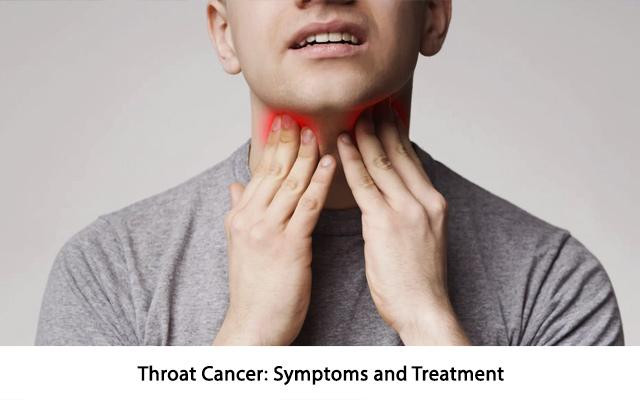Throat cancer refers to the uncontrolled growth of malignant cells in the throat, including the larynx (voice box), tonsils, and pharynx. Early diagnosis plays a crucial role in improving the chances of successful treatment. Learn more about the symptoms and treatment options for throat cancer below.
Symptoms of Throat Cancer
Throat cancer may affect the larynx or the pharynx, with symptoms varying based on the affected region. Here are the specific signs for each area.
Symptoms of Throat Cancer in the Larynx
Hoarseness or Voice Changes
A persistent change in voice, including hoarseness or a raspy tone, which may worsen over time.
Difficulty Speaking
Problems with speaking clearly or a weak, strained voice.
Chronic Throat Pain
Ongoing throat discomfort, especially when talking or swallowing.
Trouble Swallowing
Pain or a sensation of something being stuck while swallowing, which may become more severe over time.
Neck Lump
A noticeable lump or swelling in the neck caused by enlarged lymph nodes.
Breathing Issues
Difficulty breathing or wheezing as a tumour grows and narrows the airway.
Symptoms of Throat Cancer in the Pharynx
Persistent Sore Throat
A sore throat that lingers despite treatment.
Swallowing Difficulty (Dysphagia)
A feeling of food getting stuck or pain when swallowing, particularly in the throat's back region.
Unexplained Ear Pain
Sudden ear pain, typically on one side, without a clear cause like an ear infection.
Chronic Bad Breath
Persistent foul-smelling breath that does not improve with oral hygiene.
Altered Voice
A muffled or distorted voice due to structural changes in the throat.
Ongoing Cough
A persistent cough that may produce mucus or blood.
Diagnosis of Throat Cancer
To confirm throat cancer, doctors use a combination of diagnostic tests, including the following:
CT Scan
A CT (Computed Tomography) scan provides detailed cross-sectional images of the throat and surrounding structures. This imaging test helps identify abnormal growths and assesses whether cancer has spread to nearby tissues or lymph nodes.
Laryngoscopy
A laryngoscopy is performed to visually examine the throat and larynx. During this procedure, a thin, flexible tube with a camera (laryngoscope) is inserted through the nose or mouth, allowing doctors to identify abnormal tissues or tumours.
Biopsy
If abnormal tissue is detected, a biopsy is performed to collect a small tissue sample. This procedure is essential for confirming the presence of cancer cells. The biopsy is usually conducted under local anaesthesia and is a safe diagnostic method.
Treatment for Throat Cancer
The choice of treatment depends on the cancer's stage and location. Common approaches include:
Radiation Therapy
Radiation therapy uses high-energy rays to destroy cancer cells or shrink tumours. It is typically used for early-stage throat cancer and may be combined with chemotherapy. This treatment is painless and does not cause external burns.
Chemotherapy
Chemotherapy involves using powerful drugs to kill cancer cells. It is generally recommended for advanced stages of throat cancer and is often combined with radiation therapy to improve patient outcomes.
Targeted Therapy and Immunotherapy
These advanced treatments are suitable for patients whose cancer has not responded to traditional methods. Targeted therapy focuses on specific molecules involved in cancer growth, while immunotherapy enhances the body's natural defenses against cancer.
Conclusion
If you experience any symptoms related to throat cancer, seeking medical advice is vital. For expert care, consult Dr. Mukti Mukherjee, a leading throat cancer doctor in Kolkata, for accurate diagnosis and effective treatment.

